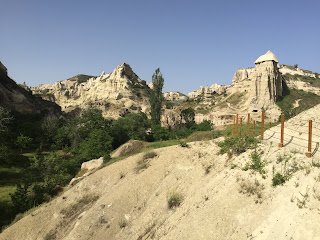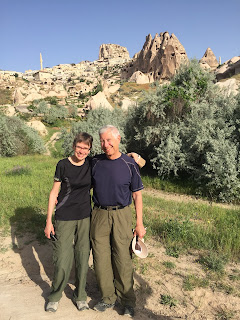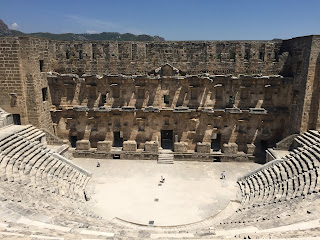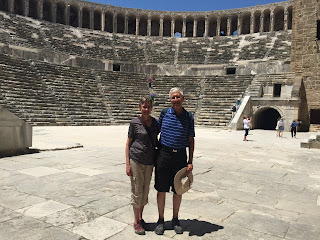Up at 5 a.m., we grabbed a quick breakfast and were on the bus for the airport by 6:30. It was an hour drive, and we got to see quite a number of balloons landing or packing up along the road. Another bus with about 40 Chinese tourists arrived just ahead of us, so the sleepy little airport had long lines.
The flight to Istanbul was uneventful, and once at the airport there we said our farewells to our tour leader and group members. We had a bit of a wait for the flight to Frankfurt, which was delayed due to some sort of air traffic control issue. That made our connection in Frankfurt very tight, so we had to move at a very fast pace through that airport.
Frankfurt to Chicago is a 9.5 hour flight, and the plane was a 747. We thought all of those had been retired, but this old bird was still flying. Mark managed to sleep a little, but Mary was not as fortunate. It turned out that the woman seated next to us was also returning from an OAT trip, but in Norway, not Turkey.
We finally arrived in Minneapolis about 11 p.m., and Katherine was kind enough to be our taxi. We got to bed about midnight -- roughly 27 hours after we had awakened in Cappadocia. We were very tired, but jet lag is strange, and we were up early again the next morning.
Turkey is a beautiful country. The time of year helped, because the winter rains make springtime very green. But the land is more lush and fertile than one imagines, especially along the coastal areas. Cappadocia has its own kind of desert beauty.
Another striking feature of Turkey is its blending of east and west. Turks like to think of themselves as Europeans (even though they make a big deal in Istanbul about spanning two continents). Western Turkey is very secular, with younger women dressing in European fashion, and almost no one pausing when the call to prayer sounds from the minarets. But as one goes farther east, the conservatism is dress and religious observance is quite obvious.
Smoking is something we had to get used to. Something like 60% to 70% of Turks smoke -- in the west, that includes many women, as well as men. We've gotten used to smokeless public spaces in the U.S., but smoke is everywhere in Turkey.
People asked us why we would go to Turkey, and why we weren't worried about safety there. Turkey has had its problems with political division and terrorism slipping across the border from Syria, but we generally felt as safe there as we would feel in any unfamiliar place in the U.S. We, too, have political division and mass shootings.
We would recommend visiting Turkey. We had a great time.
The flight to Istanbul was uneventful, and once at the airport there we said our farewells to our tour leader and group members. We had a bit of a wait for the flight to Frankfurt, which was delayed due to some sort of air traffic control issue. That made our connection in Frankfurt very tight, so we had to move at a very fast pace through that airport.
Frankfurt to Chicago is a 9.5 hour flight, and the plane was a 747. We thought all of those had been retired, but this old bird was still flying. Mark managed to sleep a little, but Mary was not as fortunate. It turned out that the woman seated next to us was also returning from an OAT trip, but in Norway, not Turkey.
We finally arrived in Minneapolis about 11 p.m., and Katherine was kind enough to be our taxi. We got to bed about midnight -- roughly 27 hours after we had awakened in Cappadocia. We were very tired, but jet lag is strange, and we were up early again the next morning.
Turkey is a beautiful country. The time of year helped, because the winter rains make springtime very green. But the land is more lush and fertile than one imagines, especially along the coastal areas. Cappadocia has its own kind of desert beauty.
Another striking feature of Turkey is its blending of east and west. Turks like to think of themselves as Europeans (even though they make a big deal in Istanbul about spanning two continents). Western Turkey is very secular, with younger women dressing in European fashion, and almost no one pausing when the call to prayer sounds from the minarets. But as one goes farther east, the conservatism is dress and religious observance is quite obvious.
Smoking is something we had to get used to. Something like 60% to 70% of Turks smoke -- in the west, that includes many women, as well as men. We've gotten used to smokeless public spaces in the U.S., but smoke is everywhere in Turkey.
People asked us why we would go to Turkey, and why we weren't worried about safety there. Turkey has had its problems with political division and terrorism slipping across the border from Syria, but we generally felt as safe there as we would feel in any unfamiliar place in the U.S. We, too, have political division and mass shootings.
We would recommend visiting Turkey. We had a great time.


















































